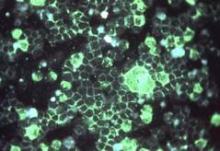Being under a month old, living with children under 5 years old, and being born during peak respiratory syncytial virus season all increase the likelihood that young children will be hospitalized with the infection, according to a 5-year, prospective surveillance study of children up to 2 years old published online July 22 in Pediatrics.
Investigators found 559 (26%) RSV-infected children among the 2,149 hospitalized with acute respiratory infections during 2000-2005 in counties that included Nashville, Tenn.; Rochester, N.Y.; and Cincinnati. Most of the children had been previously healthy, and most were born full-term (Pediatrics 2013;132:e341–e348 [doi: 10.1542/peds.2013-0303]).
The findings suggest that preventive measures – including vaccines under development – should be aimed at all young children, not just premature infants and others traditionally thought of as being at high risk, according to Dr. Caroline Breese Hall of the University of Rochester (N.Y.) and her associates.
"These findings indicate that strategies for diminishing the health care burden from RSV infections should include appropriate prophylaxis and the development of vaccines that are effective in very young infants, even those within the first month of life. In addition, general infection control practices such as restrictions of visits from ill individuals and careful hand washing should be emphasized, especially during the peak months of RSV circulation," which were December and January in this study, the authors concluded.
The RSV hospitalization rate was 5.2 per 1,000 children less than 24 months old; infants in their first month of life had the highest rate at 25.9 per 1,000 children. Infection was confirmed in the study by reverse-transcriptase polymerase chain reaction.
Infants no older than 2 months had a hospitalization rate of 17.9 per 1,000 children and accounted for 44% of RSV hospitalizations.
Ten percent of hospitalized kids were born preterm, "but their risk of hospitalization was not significantly different from that for term infants." It was a different story with very premature infants, that is, those born at less than 30 weeks’ gestation. They accounted for only 3% of RSV cases but had an RSV hospitalization rate of 18.7 per 1,000 children, about three times that of term infants, the authors noted.
Previous attempts to characterize children hospitalized with RSV have tended to rely on retrospective data – often discharge diagnoses – and have stratified risk by 6-month blocks of time. To increase precision, the authors used birth certificates to quantify risk by months of age.
About 21% of the children less than 12 months old had a comorbid condition, most often cardiopulmonary disease; coexisting medical conditions were even more common among older children, occurring in 53% of those aged 12-23 months.
The proportion of hospitalized children less than 24 months old living with another child under 5 years old (57%) was more than twice that of children living with older children (19%).
Overall, gender and race did not affect hospitalization rates.
The team did not study the effects of palivizumab – a monoclonal antibody used to prevent RSV complications in premature infants and others generally thought to be at high risk – on hospitalization rates, which "was unlikely to be appreciable because only a small proportion (less than 5%) of our study population was eligible" to receive it, the team noted.
The Centers for Disease Control and prevention funded the work. Six of the 14 authors reported research funding from or speaking, advising, or consulting relationships with several companies, including GlaxoSmithKline, MedImmune, Merck, Sanofi Pasteur, Novartis, BD Diagnostics, Novavax, and Quidel. Some of those firms are involved with RSV vaccine development.


